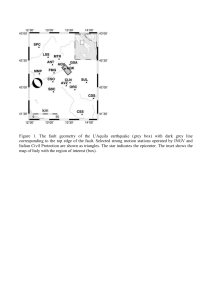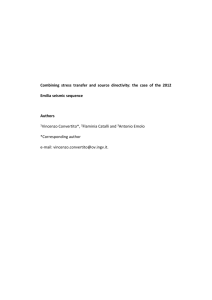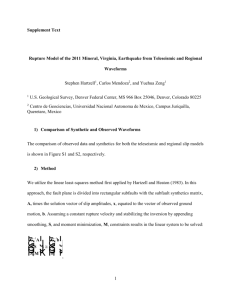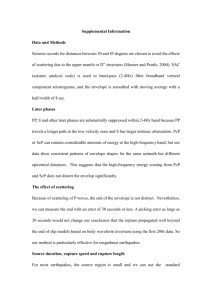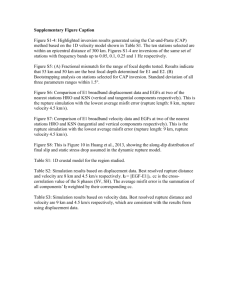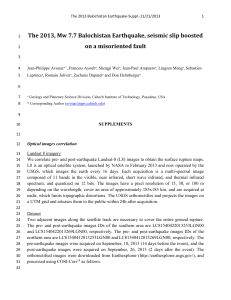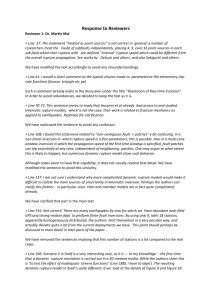Source rupture process of Colima, Mexico earthquake
advertisement
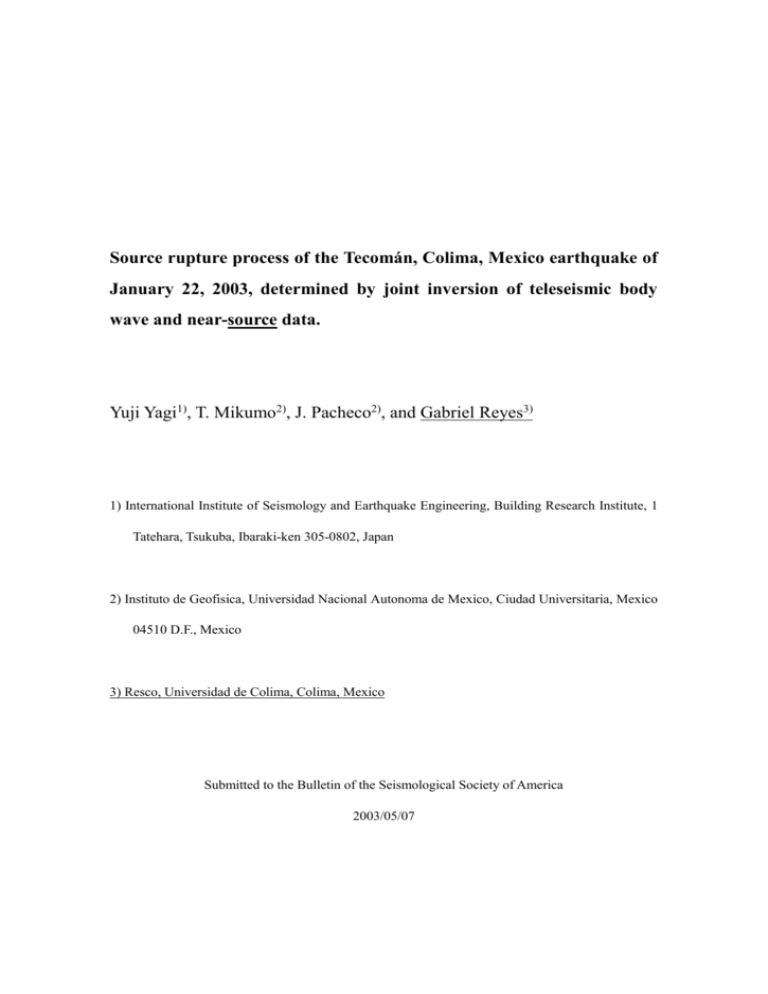
Source rupture process of the Tecomán, Colima, Mexico earthquake of January 22, 2003, determined by joint inversion of teleseismic body wave and near-source data. Yuji Yagi1), T. Mikumo2), J. Pacheco2), and Gabriel Reyes3) 1) International Institute of Seismology and Earthquake Engineering, Building Research Institute, 1 Tatehara, Tsukuba, Ibaraki-ken 305-0802, Japan 2) Instituto de Geofisica, Universidad Nacional Autonoma de Mexico, Ciudad Universitaria, Mexico 04510 D.F., Mexico 3) Resco, Universidad de Colima, Colima, Mexico Submitted to the Bulletin of the Seismological Society of America 2003/05/07 Abstract The spatial and temporal slip distribution of the Tecomán, Colima, Mexico earthquake is estimated from near-source strong motion and teleseismic body wave data. To perform stable inversion, we incorporated prior information into observed data, and determined the optimal relative weights of information from the observed data and prior constraints using an optimized Akaike's Bayesian Information Criterion (ABIC). The derived source parameters are as follows: (strike, dip, slip) = (300°, 20°, 93°), seismic moment Mo = 2.3 x 1020 Nm; source duration = 30 sec; fault length = 35 km; fault width = 70 km. We found that the rupture process can be divided into three stages: the rupture nucleated near the hypocenter (Stage I), then it broke the first asperity centering about 15 km southwest from the epicenter (Stage II); the rupture propagated to the northeast and second asperity was broken (Stage III). We also estimated the shear stress change due to the rupture process of the mainshock on and around the major fault zone. It appears that two clusters of aftershocks for the first 5 days took place mostly in and adjacent to the zones of stress increase due to the fault rupture during the mainshock. 1 1. Introduction On January 22, 2003, a powerful earthquake struck part of southern and central Mexico, killing at least 21 people and causing serious damage, mainly in the state of Colima. The earthquake information initially provided by the U.S. Geological Survey was as follows: origin time = 22/01/2003 02:06:35 (UT); epicenter = 18.807°N, 103.886°W; depth = 30 km; moment magnitude = 7.8. In this region, the oceanic Rivera (RIVE) and Cocos (COCOS) plates subduct beneath Mexico which forms part of the continental North American (NOAM) plate, where four great earthquakes occurred on 3 June 1932 (Ms 8.1), 18 June 1932 (Ms 7.8), 30 January 1973 (Ms 7.5), and on October 10, 1995 (Ms 7.3; Mw 8.0). The tectonic settings and aftershock areas of these great earthquakes are shown in Figure 1. The 2003 Tecomán, Mexico earthquake occurred near a diffuse-triple junction, although the boundary between the RIVE and COCOS plates is uncertain (e.g. Bandy et al., 1995; DeMets and Wilson, 1996). The convergence rate between the RIVE-NOAM and COCOS-NOAM near the junction is roughly equal to 5 cm/year (DeMets and Stein, 1990; Bandy et al., 1995). To gain an understanding of the seismotectonics of this region, it is important to investigate the co-seismic slip area of these great earthquakes. In general, the teleseismic body waves contain the information on the overall moment release rate and the depth range of the rupture area, while the near-source waveforms contain most of the information on the detailed slip process in the source area. Therefore, to estimate the detailed and stable source process, it is important to use both the teleseismic body wave and near-source data. In this study, we constructed a detailed source model of this earthquake, using the near-source records obtained by the Universidad Nacional Autonoma de Mexico (UNAM) plus the teleseismic data collected by the Data Management Center of the Incorporated Research Institutions for Seismology (IRIS-DMC). Latter, we compared stress change due to the co-seismic slip with aftershock distribution. 2 2. Data We retrieved teleseismic body wave (P- and SH-waves) data recorded at IRIS-DMC stations via the Internet. Fourteen components at 12 stations were selected from the viewpoint of good azimuthal coverage. The locations of seismograph stations are shown in Figure 2. The teleseismic body waves were windowed for 60 sec, starting 10 sec before the origin time, band-passed between 0.01 and 0.8 Hz and then converted into ground velocity with a sampling time of 0.25 sec. Figure 3 shows theoretical waveforms for different source depths and observed waveforms. The shape of theoretical waveforms vary with depth due to varying the timing of the reflected phases (e.g. pP and sP). The shape of the observed waveforms are well similar to the theoretical waveforms for a depth of 20 km. This implies that the depth of major moment release is located near 20 km. We also used 18 components of strong motion data obtained from 3 broadband seismograph stations of the Servicio Sismologico Nacional (SSN), UNAM, and from 3 accelerograph stations of Instituto de Ingenieria, UNAM. The locations of these near-source stations are shown in Figure 1. The acceleration data were band-passed between 0.01 and 0.5 Hz and numerically integrated to ground velocity with a sampling time of 0.25 sec; and the broadband velocity data were band-passed between 0.01 and 0.5 Hz with a sampling time of 0.25 sec. Since the start time of near-source strong motion is not accurate, we made time corrections so that the observed P-wave arrivals coincide with the theoretical arrival time of P-waves. The broadband velocity seismogram recorded at the cjig station and its waveforms amplified by 100 times are shown in Figure 4. It is possible to identify small-amplitude motions lasting for 4 sec before a large-amplitude phase. Since this small phase is too diminutive to identify on teleseismic body waveforms, it was difficult to detect the first motion of the P-wave at teleseismic seismograph stations. We then applied timing corrections that are estimated for each teleseismic station by comparing the observed waveform with synthetics waveform obtained from the inversion of 3 near-source data. 3. Waveform inversion To construct the source model in an objective fashion, we developed a numerical method for the previous waveform inversion scheme (e.g. Harzell and Heaton, 1993; Yoshida, 1992). Following the formulation of Yoshida (1992), we represented the rupture process as a spatio-temporal slip distribution on a fault plane. First, we divided the fault plane into M x N subfaults with length dx and width dy. Next, we described the slip-rate function on each subfault with linear B splines that are a series of L triangle functions with rise time . Finally, we described the fault slip vector with K basis slip vectors. Using the above source model, the observed seismic waveform at the station j is expressed by W jobs ti X mnlk g mnkj ti l 1 Tmn e j mnlk , (1) where Xmnkl is the kth component of slip at the mnth subfault at the lth time step; gmnkj(t) is the green’s function (elementary wave from a point source at the mn-subfault with unit slip); Tmn is the start time of the basis function at each subfault; ej is assumed to be the Gaussian error with variance of j. We calculated the Green’s functions for teleseismic body waves using Kikuchi and Kanamori (1991)'s method. Green's functions for near-source ground motion were calculated by the discrete wave number method developed by Kohketsu (1985). The source-region structure models used to compute both the teleseismic body wave and near-source ground motion are given in Table 1. To explain the observed waveform, we modify the structure model given in Pacheco et al. (1997). We have also added a layer of 1-km thick wave for teleseismic body wave to model complicated water reverberations. In the present case, considering the quality of the observed records, we took j in the near-source, far-field P-waves, and SH-waves as 20 %, 10 % and 20 % of their maximun amplitude, 4 respectively. The observation equation of (1) can be rewritten in vector form as Yj = Ajx + ej, (2) where Aj is a matrix of nj (number of data points at station j) x Na (number of model parameters) dimension. In general, an increase in the number of model parameters may give rise to instability in the solution with the result that even a small change in the data will result in a large change in the solution. To obtain more stable results, we applied smoothing constraints to the slip distribution with respect to time and space. The smoothness constraint with respect to time is 0 X mnk ( l 1) 2 X mnkl X mnk ( l 1) et , 2 l L 1, (3) where et is the Gaussian error. This can be rewritten in the following simple vector form 0 = Tx +et, (4) where T is N1 x Na matrix (N1 = MN(L-2)K). The smoothness constraint on the spatial distribution of total slip is introduced by a Laplacian finite difference operator: 0 X ( m 1) nkl X ( m 1) nkl X m ( n 1) kl X m ( n 1) kl 4 X mnkl ed l X 0 nkl X m 0 kl X ( M 1) nkl X m ( N 1) kl 0 , This can be rewritten in the following simple vector form 5 (5). 0 = Dx +ed, (6) where D is N2 x Na matrix (N2 = MNK). For the analysis of seismic waves, using the observed data with two constraints, we determine the model parameters that minimize the sum of squared residuals S, given by S x, j , t , d j 1 2j 2 y j A jx 1 t2 Tx 2 1 d2 Dx 2 , (7) For given values of ’s, we can determine the best estimates of model parameters using the least-squares method discribed by Jackson and Matsu’ura (1985). The values of t and d cannot be estimated directly, but j can be estimated by the quality of data. To determine t and d objectively, we adopted the minimum Akaike’s Bayesian information criterion (ABIC) (Akaike, 1980). The optimal ABIC fomulation of two types for partially-dependent prior information was developed by Fukahata et al. (2003a, 2003b), and its validity has already been checked. The optimal ABIC for the present case is expressed using the following equation: ABIC x, t , d N log S x* , j , t , d log 1 t2 Tt T 1 d2 Dt D log 1 j 2 j A tj A j 1 t2 Tt T 1 d2 Dt D C (8) N is the total number of the observation equations. We apply a grid-search method to obtain optimal values of t and d. In this paper, to solve the least squares problem with a positivity constraint on the model parameters, we employed the non-negative least squares (NNLS) algorithm of Lawson and Hanson (1974). 6 4. Fault model We assumed that faulting occurs on a single fault plane, and that the slip angle remains unchanged during the rupture. We adopted the fault mechanism of (strike, dip, slip) = (300°, 22°, 93°), and the epicenter determined by Colima University (Latitude = 18.71°N; Longitude = 104.13°W). This fault mechanism is modified slightly from the Harvard CMT solution to be consistent with the amplitude of P-waves and with the geometry of the plate boundary that has been determined by the focal mechanism and seismicity (Pardo and Suárz, 1995). In order to obtain gross features as well as some details of the rupture process, we divided the procedure into two steps. In the first step, we took a broad fault area of 100 km x 90 km to obtain a rough estimate of the rupture area, which we divided into 10 x 9 subfaults, each with an area of 10 km x 10 km. If the start time of the basis function at each subfault Tmn of Equation (1) is set to 0 sec, we can allow all subfault to slip at any time. Although this model is flexible, the computation time is long. To save the computation time, we assume a first rupture front velocity Vi, which gives the start time of the basis function at each subfault Tmn of Equation (1). The Vi is set to 3.5 km/sec, about the shear-wave velocity in the source region. We tested a range of values from 2.0 to 4.5 km/sec and found 3.5 km/sec to be most suitable. The slip-rate function on each subfault is expanded into a series of 8 triangle functions with a rise time of 2 sec. Since the hypocentral depth is not adequately constrained by the local seismological network, so we varied the hypocentral depth from 10 to 35 km in increments with 2.5 km in the inversion procedure with the fault mechanism and epicenter fixed, and found its minimum variance at 20 km (Figure 5). Through the inversion procedure, the effective rupture area was estimated to be 40 km x 70 km. In the second step, the fault plane was confined to a narrower area of 70 km x 85 km and divided into 14 x 17 subfaults, each having an area of 5 km x 5 km. The slip-rate function on each subfault is expanded into a series of 13 triangle functions with a rise time of 1 sec. The rupture front velocity is 7 also set at 3.5 km/sec in this case. 5. Source Model The inversion results are shown in Figures 6, 7 and 8. Figure 6 shows the final dislocation on the fault plane, Figure 7a depicts the final dislocation plotted on the map. Figure 8 represents a snapshot of the slip-rate at every 2 sec. The source rupture process obtained may be divided into three stages from I to III. At Stage I, the rupture nucleated near the hypocenter during the initial stage of 4 sec. The seismic moment at this stage is 2.5 x 1018 Nm (Mw 6.2), which is significantly smaller than the total seismic moment. At Stage II, the rupture propagated to the southwest and broke the first asperity (A) centered about 15 km southwest from the epicenter during 4 to 10 sec after the initial break. The seismic moment at this stage is 2.5 x 1019 Nm (Mw 6.9). At Stage III, the rupture propagated to the northeast and broke asperity (B) centered about 25 km northeast from the epicenter. Figure 7b shows the slip function inferred for subfaults near the asperities. The mean source time function at asperity A, and B lasts about 7 and 6 sec, respectively. The source time function consists of the dislocation rise time and the rupture propagation time. In the present case the rupture propagation time is about 2 sec. Accordingly, the mean rise times at A and B are about 5 and 4 sec. The maximum slip amounts to 3.4 m at about 15 km southwest of the epicenter. Total seismic moment is Mo = 2.3 x 1020 Nm (Mw = 7.5), which is in agreement with that of the Harvard CMT: 1.62 x 1020 Nm. The total source duration is about 30 sec. The rupture propagates mainly along the dip direction, and the length of the rupture area is significantly shorter than its width. The rupture area appears to extend parallel to the transition zone between the RIVE and COCOS plates. It is to be noted that the hypocenter is located near a narrow part of the slip area, where the amount of slip is very small. Figure 10 displays a comparison between the observed records (black) and the synthetics (gray). 8 The waveform match is very good except for the MOIG station located 329 km northeast of the hypocenter. The discrepancy for this station may come from the assumed structure which is not suitable for the station. In the present analysis, the near-source data is very limited in azimuthal coverage. Stations CALE, VILE, UNIO and ZIIG are nearly in the same azimuth; Waveform observed at MOIG cannot be constructed by our source model, so effectively there are two azimuths represented. Although this is not a good data set when compared to most strong motion inversions, our result seems to have a good resolution. This result may come form the advantage of the joint inversion of teleseismic body wave and strong motion data with an optimized ABIC. Fukahata et al., (2003a, 2003b) show that the optimized ABIC are particularly useful even with the insufficient observed data set. As shown before, the slip distribution of the 2003 Tecomán earthquake extended in the northeast direction. The rupture pattern should affect the distribution of seismic intensity. Singh et al. (2003) obtained an isoseismal map based on reports mainly from local government agencies and from field inspection teams. Their results show that a large ground motion area with VIII on the modified Mericalli intensity scale extended to the northeast, which is consistent with that expected from the effect of our source model. 6. Coseismic stress change and aftershock distribution We also estimate the coseismic change of shear stress on and around the dipping fault plane due to the rupture process of the mainshock, to compare it with aftershock distribution. Calculations of the shear stress change is based on the slip distribution (Figure 7) obtained from the afore-described waveform inversion; The first method is from formulations for static disloaction in a homogeneous half-space (Okada, 1992), and the second one is from an extension of a 3D dynamic rupture model embedded in a horizontally layered structure (Mikumo and Miyatake, 1993; Mikumo et al., 2002). In 9 the latter case, the crust and uppermost mantle velocity structure given in Table 1 is incorporated, while the velocity structure in the third layer is used for the homogeneous space in the first case. Comparing the calculated results from the above two ways, we see that the stress changes in the central fault section are almost the same, while the dynamic model provides somewhat larger values near the prescribed fault edges due to the propagating rupture. Since we are mainly interested in the stress change in the major part of the fault to see if there is any possible correlation with aftershock distribution, we show, in Figure 11, the static shear stress change obtained from the first method. It is found that the maximum stress drop in a zone of large slip of 3.1 m (asperity B) northeast of the epicenter is about 9.4 MPa, and that in a zone of large slip of 3.4 m (asperity A) is about 10.7 MPa. On the other hand, we notice a zone of stress increase up to 4.5 MPa trending in the NE-SW direction just northeast of the epicenter, and another zone of stress increase of 4.0 MPa west of large stress drop zone (asperity B). The mainshock of the January 22, 2003 earthquake (02:06:35) was followed by quite a large number of small to moderate-size (Mw < 5.8) aftershocks, but its major activity seems to have decayed in the first two weeks. The locations of these aftershocks have been determined from 10 stations of the Red Sismica de Universidad de Colima (RESCO). Figure 11 also shows the locations of 130 aftershocks for the first 5 days after the mainshock event, superposed on a map of the shear stress change. It can be seen that there are three main clusters of aftershocks; one is trending in the NNE-SSW direction just northeast of the mainshock epicenter, the second one has the WNW-ESE trend extending westward from the epicenter., and the third one is nearly parallel to and located northeast of the second cluster. Two largest aftershocks, Mw=5.8 (19:41, January 22) and Mw=5.3 (20:15, January 22), took place near the western end of the second cluster. It is interesting to note that the first cluster occurred in and adjacent to the zone of stress increase located southeast of asperity B, and that the second cluster also took place in the zone of stress increase. On the other hand, the third cluster appears to traverse the southern part of stress drop zone near asperity B. Also 10 to be noted here is the lack of aftershock activity in and around a zone of large stress-drop zone, asperity A, although this might be due to some incapability of aftershock loactions from the inland seismic stations. These patterns suggest that many of these aftershocks, except part of the third cluster, appear to have been triggered by stress increase due to nonuniform rupture process of the mainshock covering a wide fault area. Later aftershock activity expanded to the surrounding regions. 7. Summary We constructed a detailed source model of the January 22, 2003, Tecomán, Colima, Mexico earthquake, using the near-source records obtained by the UNAM plus the teleseismic data collected by IRIS-DMC. To construct the source model in an objective fashion, we developed a numerical method. We incorporated prior information into the observed data, and determined the optimal relative weights of information from the observed data and prior constraints using an optimized ABIC. We found that the rupture process can be divided into three stages: the rupture nucleated near the hypocenter (Stage I), then it broke the first asperity centering about 15 km southwest from the epicenter (Stage II); the rupture propagated to the northeast and large asperity was broken (Stage III). The rupture area appears to extend parallel to the transition zone between the RIVE and COCOS plates. The hypocenter is located near a narrow part of the slip area, where the amount of slip is very small. It appears that two clusters of aftershocks for the first 5 days took place in and adjacent to the zones of stress increase due to the fault rupture during the mainshock. 11 Acknowledgments The broadband and accelerogram data used in the present study are from the Servicio Sismologico Nacional of Instituto de Geofisica, and Instituto de Ingenieria, of Universidad Nacional Autonoma de Mexico. We are grateful to Dr. Shri Krishna Singh for making these data available for the present study. The aftershock data have been provided by the RESCO, Universidad de Colima, Mexico. We thank Dr. Yukitoshi Fukahata for his beneficial advice on ABIC formulation. We also thank Dr. D. J. Wald and Dr. Chen Ji for their critical reviews. This study is partly supported by the CONACyT (Mexico) project No. 41209-F. 12 References Akaike, H. (1980). Likelihood and Bayes procedure, in Bayesian Statistics, edited by J. M. Bernardo, M. H. DeGroot, D. V. Lindley, and A. F. M. Smith, pp. 143-166, University Press, Valencia, Spain. Bandy, W, C. Mortera-Gutíerrez, J. Urrutia-Fucugaushi, and T. W. C. Hilde (1995). The subducted Rivera-Cocos plate boundary: Where is it, what is it, and what is its relationship to the Colima rift? Geophys. Res. Lett., 22, 3075-3078. DeMets, C. and S. Stein (1990). Present-day kinematics of the Rivera plate and implications for tectonics of southwestern Mexico, J. Geophys. Res., 95, 21931-21948. DeMets, C. and D. S. Wilson (1996). Relative motions of the Pacific, Rivera, North American, and Cocos plates since 0.78 Ma, J. Geophys. Res., 102, 2789-2806. Fukahata, Y., A. Nishitani and M. Matsu'ura (2003a). Geodetic data inversion using ABIC to estimate slip history during one earthquake cycle with viscoelastic slip-response functions, Geophys. J. Int., in print. Fukahata, Y., Y. Yagi, and M. Matsu'ura (2003b). Waveform inversion for seismic source processes using ABIC with two sorts of prior constraints: Comparison between proper and improper formulations, Geophys. Res. Lett., 30, 10.1029/2002GL016293. Hartzell, S. H. and T. H. Heaton (1983). Inversion of strong ground motion and teleseismic waveform data for the fault rupture history of the 1979 Imperial Valley, California earthquake, Bull. Seism. Soc. Am., 73, 1553-1583. Jackson, D. D. and M. Matsu’ura (1985). A Baysian approach to nonlinear inversion, J. Geophys. Res., 90, 581-591. Kanamori, H. and D. L. Anderson (1975). Theoretical basis of some empirical relations in seismology, Bull. Seism. Soc. Am., 65, 1073-1095. Kikuchi, M. and H. Kanamori (1991). Inversion of complex body wave-III, Bull. Seism. Soc. Am., 81, 13 2335-2350. Kohketsu, K. (1985). The extended reflectivity method for synthetic near-field seismograms, J. Phys. Earth, 33, 121-131. Lawson, C. L. and R. J. Hanson (1974). Solving Least Squares Problems, Prentice-Hall, Inc., Englewood Cliffs., New Jersey. Mikumo, T. and T. Miyatake (1993). Dynamic rupture processes on a dipping fault, and estimates of stress drop and strength excess from the results of waveform inversion, Geophys. J. Int., 112, 481-496. Mikumo, T., Y. Yagi, S.K. Singh, and M.A. Santoyo (2002). Coseismic and postseismic stress changes in a subducting plate: Possible stress interactions between large interplat thrust and intraplate normal-faulting earthquakes, J. Geophys. Res., 107, B1,10, ESE 5-1 – 5-12. Okada, A. (1992). Internal deformation due to shear and tensile faults in a half-space, Bull. Seism. Soc. Am., 82, 1018-1040. Pacheco, J., S. K. Singh, J. Domínguez, A. Hurtado, L. Quintanar, Z. Jiménez, J. Yamamoto, C. Gutiérrez, M. Santoyo, W. Bandy, M. Guzmán, V. Kostoglodov, G. Reyes., and C. Ramírez (1997). The October 9, 1995 Colima-Jalisco, Mexico earthquake (Mw 8): an aftershock study and a comparison of this earthquake with those of 1932, Geophys. Res. Lett., 24, 2223-2226. Pardo, M. and G. Suárz (1995). Steep subduction geometry of the Rivera plate beneath the Jalisco block in western Mexico, Geophys. Res. Lett., 20, 2391-2394. Singh, S K., J. F. Pacheco, L. Alcántara, G. Reyes, M. Ordaz, A. Iglesias, S. M. Alcocer, C. Gutierrez, C. Valdés, V. Kostoglodov, Carlos Reyes, T. Mikumo, R. Quaas and J.G. Anderson (2003). A Preliminary Report on the Tecomán, Mexico Earthquake of 22 January 2003 (Mw7.4), Seism. Res. Lett, 74, 279-289. Yoshida, S. (1992). Waveform inversion for rupture process using a non-flat seafloor model: application to 1986 Andreanof Islands and 1985 Chile earthquake, Tectonophysics, 211, 45-59. 14 Affiliations and address of authors Yuji Yagi International Institute of Seismology and Earthquake Engineering, Building Research Institute, 1 Tatehara, Tsukuba, Ibaraki-ken 305-0802, Japan e-mail: yagi@kenken.go.jp TEL: +81-29-864-6755 FAX: +81-29-864-6777 Takeshi. Mikumo, and Javier Pacheco Instituto de Geofisica, Universidad Nacional Autonoma de Mexico, Ciudad Universitaria, Mexico 04510 D.F., Mexico Gabriel Reyes Resco, Universidad de Colima, Colima, Mexico 15 Table 1. Structure Vp Vs Density km/s km/s 103 kg/m3 Qp Qs Thickness (km) For teleseismic body wave 1.5 0 1.0 1.0 5.54 3.20 2.50 3.0 5.69 3.29 2.70 5.0 6.27 3.62 2.80 9.7 6.71 3.87 2.90 17.3 8.10 4.68 3.30 - For strong ground motion 5.54 3.20 2.50 300 150 4.0 5.69 3.29 2.70 500 250 5.0 6.27 3.62 2.80 600 300 9.7 6.71 3.87 2.90 800 400 17.3 8.10 4.68 3.30 1200 600 - 16 Figure captions Figure 1 Geographic map showing the epicentral location (star) of the 2003 Tecomán, Colima, Mexico earthquake. RFZ: Rivera Fracture Zone, EPR: East Pacific Rise, EGG: El Gordo Graben, SRC: Southern Colima Rift. The contours show the aftershock area of large/great earthquakes in the region (modified from Singh et al., 2003). The black triangles and gray triangles indicate broadband seismograph stations and accelerograph stations, respectively. The focal mechanism was determined by our study. Figure 2 Teleseismic station map shown as a map view. The star represents the epicenter of the mainshock. Figure 3 Theoretical waveforms (gray curves) at different source depths and observed waveforms (black curves). Figure 4 Seismograms recorded at cjig station. The top trace is the vertical component of the velocity waveform, and the bottom trace is amplified 100 times. Figure 5 Waveform variance determined from the preliminary analysis plotted as a function of hypocentral depth. The differences from the minimum (depth = 20.0 km) are shown. Figure 6 Final results of our joint inversion. (a) Focal mechanism (b) Total moment-rate function. (c) Distribution of coseismic slip vectors. The star indicates the location of the initial break. Figure 7 (a) Distribution of coseismic slip on the map. The star indicates the location of the initial break. (b) Slip functions obtained in this study for subfaults A and B shown in Figure 6. Figure 8 Snapshots of surface projection of the slip-rates at every 2 sec. The star indicates the epicenter of the 2003 Tecomán, Mexico earthquake. Figure 9 Comparison of the observed waveforms (upper trace) with the calculated waveforms (lower trace). The numbers below the station code indicate the maximum amplitude. (a) 17 Teleseismic body wave (b) Strong motion data. Figure 10 Distribution of coseismic stress change and 130 aftershocks for the first 5 days. Dark-shaded and white areas indicate the zones of stress decrease and increase, respectively. The star indicates the mainshock epicenter. Locations of the mainshock and all aftershocks have been determined by RESCO. 18
